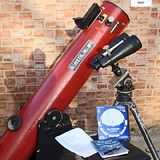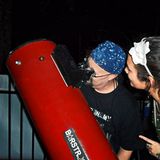
Inspiring tips from Duke Skygawker on how to publicize and host a successful astronomy outreach event.
Hosting an astronomy outreach event is probably the most rewarding and fun way to share the night sky with others. But doing astronomy outreach doesn't do much good if there's no one there to reach out to. So how do you make sure appreciative people are on hand to enjoy the astronomical wonders you'd like to share with them?
This article shares a number of tried and true strategies to help you advertise, brand, and effectively gain participants to your astronomy observing events. I start with strategies for getting the word out about traditional events at your local observatory or club, followed by strategies for nontraditional outreach events, like sidewalk astronomy, or my personal venture, Barstronomy
TRADITIONAL EVENTS:
It's very important to establish a presence in the market, especially if you count on the revenue from admission to help fund your operations. Being an established group or facility has its advantages, including potential patrons' ability to count on the fact that you have a public program on a recurring schedule.
My "home" dome, Perkins Observatory in Delaware, Ohio, does public outreach almost every Friday night, rain or shine, except holidays and in July. In this way, the public can count on a program whether or not sky views are possible. An entertaining talk about "what you would have seen," along with tours of the historic observatory-its "ghost story," many types of telescopes, and a full library go a long way toward salvaging a cloudy program night, and there's lots of those in central Ohio. Maybe you're luckier where you're located.
Manned by staff (only two people), Perkins counts on volunteers from the Columbus Astronomical Society to help park cars, operate telescopes on the front lawn, and engage program attendees in one-on-one conversation about the heavens. So these programs serve "double duty" as CAS outreach events, with all revenues going to Perkins, and the club earns its funds via member dues.
Perkins makes it easy to find program information: just go to their website. They're part of Ohio Wesleyan University, and right on the front page, you see this a list of their upcoming events.
Social Media:
Perkins observatory also has a Facebook page, promoting their programs and space news, and the CAS uses their Facebook and web presence to do the same. If your local club doesn't have a Facebook page, consider setting one up to get the word out and to document your events. You might even consider using Twitter and Google+ as well.
Media Presence:
Along with their own sites and pages, the "O" makes sure local newspapers and media outlets have their schedule, updated every few weeks, to ensure the programs will appear on local "things to do" calendars. Familiarize yourself with your local media outlets and establish a contact who you can send press releases or links to events pages-remember to give them a few weeks notice to increase the chances of them including your event. You might even be able to post your events directly to online events pages of your local media outlets.
It also helps to have a charismatic staffer to maintain a strong media presence, and Perkins' Director Tom Burns does exactly that. He uses his extensive knowledge, well-honed routine and genuine enthusiasm to write regular print articles, make radio and TV appearances, and serve as a very visible ambassador. Establishing a presence as the "go-to" person to ask about any astronomy news or sky event helps strengthen the brand as well.
Radio and TV public service announcements (PSAs) are yours for the asking, if you're a nonprofit or educational institution, as most doing public astronomy outreach are.
Event Flyers and Posters:
There are other things that can also help your scheduled, traditional astronomy programs reach a wide audience. Attractive posters are a great tool for creating visual enticement to attend. Display them in area businesses; busy coffee shops and cafes, for instance, as well as in libraries and government facilities. Design your posters to be eye-catching, and don't try to cram too much text onto them-most people will only have time for a quick look, so display the time and date prominently, with a brief summary of what to expect and your website or contact info for interested parties. Here is an excellent example of an event flyer, by the Austin Astronomical Society in Texas:
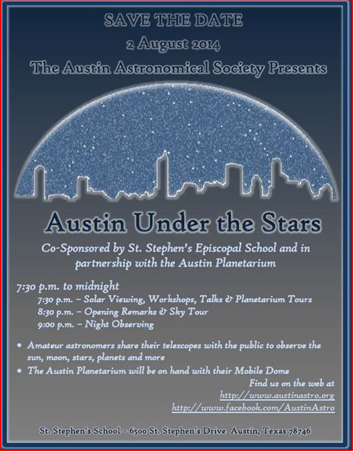
Most astronomy outreach events are great family activities, so be sure to advertise that kids are welcome, (if they are), and you'll likely see an increase in families marking their calendar for your event.
Signage at Your Event Site:
Good visible signage near your location, if possible, makes your site easy to find at program time, and is also a constant reminder to those who drive, bike, or walk by.
Embrace Your Current Followers:
Don't forget to preach to the faithful, either. Your observatory or club newsletter can go a long way in cajoling your members and patrons to talk about your programs, get them to return, and bring other patrons with them, too. The Austin Astronomical Society in Texas does this very well in their newsletter, publishing their event schedule, a full-color poster, and a regular request for members to print copies and post the information in their neighborhoods and nearby businesses. (Note not for publishing: included picture files of these items, using one or more at your discretion). The Austin Astronomical Society also publishes an outreach activity report each month, so members can understand how they're impacting the public, and be inspired to continue those efforts.
Word-of-Mouth:
Finally, don't discount word-of-mouth, always one of the best plugs there is-as long as your patrons have a positive experience! People who come away from your program satisfied and amazed are going to talk about it to their friends and neighbors, and that brings more visitors.
Many clubs not associated with an observatory or directly with another institution, often hold regular public observing nights in other locations, such as a school, park, or club observing site. The same methods of promoting the event are applicable to these as well.
NONTRADITIONAL EVENTS:
First, let's identify what a "nontraditional" astronomy outreach event might be. A good example is the one started by John Dobson and the San Francisco Sidewalk Astronomers. This sidewalk astronomy method of taking scopes to the city streets and parks, rather than making people come to an observatory or dark-sky observing site, serves to reach out to those who don't make up the usual program audience. The people you'll be interfacing with are passers-by, likely attending a nearby event or attraction, and it can be a great pleasure for them to unexpectedly stumble on you and your telescope. Many of the people you'll meet may be looking through a telescope for the very first time!
The
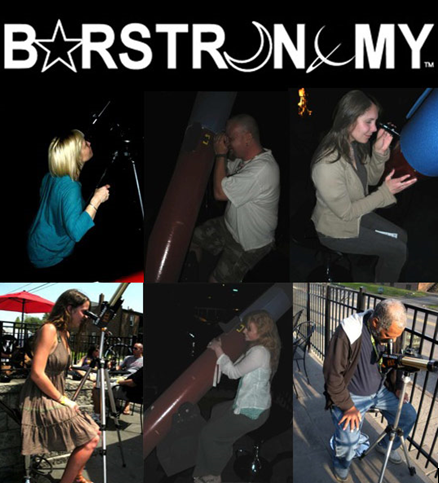
Internet Buzz:
Sure, the element of surprise is a beautiful thing when it comes to sidewalk astronomy and nontraditional events, but it also helps to let as many people as possible know about your planned set-up location, time and date.
Websites and social media can make a big difference. If you are able to drive traffic to your website, gain friends on Facebook, followers on Twitter and Instagram, and group members on Google+, these are great platforms to publicize your events.
Many "sidewalk" type outreach efforts take place on a regular basis, but others don't. For the more spontaneous, short-advance-notice type events, which may not take place until conditions are just right, the Internet is an "instant" way to get the word out to potential attendees-working much faster than newspapers, print ads, or newsletters.
Email Lists:
Email can play a very supportive role as well. If you capture email addresses from those who view at your sidewalk event, and are careful not to "spam" them or let others use your hard-earned email list, you can generate repeat visitors, and let those on the list inform others if they wish. The best way to get people to sign up for your email list is to inform them of exactly what to expect-that you'll be sending event info, and how frequently you'll be sending it. Most people won't sign up for an email list if they think you'll be peppering them with emails every single day, but monthly or bi-monthly email is usually a more-than-welcome approach.
Location, Location, Location:
But really, the best way to generate an audience for this type of outreach is to go where the crowds are! Don't worry about the city lights-just make sure you have a good line-of-sight to at least a couple of bright targets, like the Moon and Jupiter. The most important thing you can do for this type of outreach is just show up!
That said, don't just walk into a private venue or location and begin setting up. You do need to clear it with the owners or managers, whether it's a restaurant, bar, city park, library, or government building.
And remember, the just show up method is most effective when you are able to go where a crowd will be gathering for a popular scheduled event or venue-it may be a concert, sporting event, festival, or well-known bistro or watering hole.
City sidewalks do not require permission, although it's definitely advisable to let the police department or similar authority know what you're doing. They'll appreciate the heads-up. Be sure not to impede traffic or interfere with event operations so that you'll be welcomed back next time.
Signage:
Placing posters around your setup area will help you grow an audience, especially because people won't be expecting astronomical observing, and didn't come to the locale with that in mind.
The ubiquitous "quarter-sheet" flyer, which can be printed up quickly, cut and handed out to passersby, is a good way to let them know what's going on. A large banner, suitable for hanging on a fence, wall, window, or over a door, can also draw curious people who want to find out what it's all about. A "Moon Viewing" banner, for instance, can be reused many times, especially if you use sturdy material. Here's an example of a Barstronomy flyer:
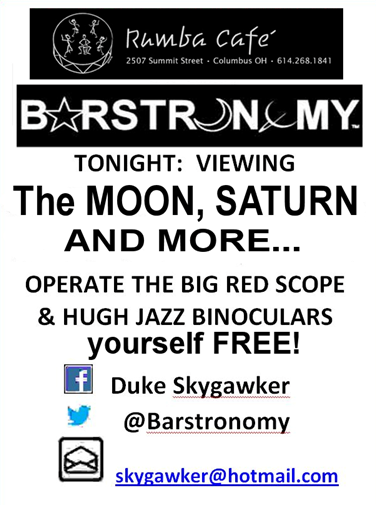
Radio and Media:
If you've managed to gain some branding in your area, you may find local radio stations willing to take a call to promote your appearance. Electronically-generated news releases work too, if you're able to get them to daily media outlets at least two days in advance, although weekly newspapers will often need a bit more notice.
On-site Networking:
As you talk to your site hosts and attendees, always remind them you can be available for their location or other special programs. You'll be surprised how this type of networking can lead to other opportunities to bring astronomy to nontraditional audiences.
Sidewalk Equipment:
One other thing I think is very important: If possible, use equipment people can get their own hands on and operate. That's not usually the case for traditional programs, but it's the best way to go for "sidewalk" type venues. In other words, don't bring your Takahashi with a mint finish, or your best $1,000 eyepieces. Better is a nice simple 6-10" Dobsonian and some serviceable but inexpensive eyepieces. Have a red-dot finder like the
Tracking Trick for the Newbie:
People may have trouble tracking if they're worried about how the scope is moving, so here's an easy analogy I've found that works nearly 100 percent of the time: ask your participants if they've used a mouse to move a cursor around a computer screen. (Almost everyone has.) Then just tell them the object is the cursor, the FOV is the screen, and the end of the scope is the mouse. It can be one of the most effective ways to bring a successful hands-on, interactive experience to your outreach guests. And that success may just lead them to understand that telescopes don't have to be expensive and complicated to show some great views and get them to be a lifelong personal astronomy enthusiast. And isn't that what we want? I think it is!
Share your tips for hosting a successful astronomy outreach event in the comments!
Tony Miller, aka "Duke Skygawker," is a native Ohioan who watched the sky from an early age but never took up astronomy as a hobby until well into his 40s. His professional background is in broadcast media, journalism, and performing arts, which have certainly influenced his involvement in astronomy outreach. He can be found on Twitter (Barstronomy on Twitter) and on Facebook (Duke Skygawker), as well as at Columbus, Ohio music venues and rural dark-sky sites.




